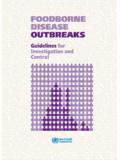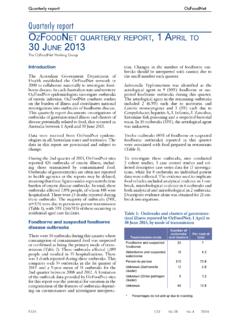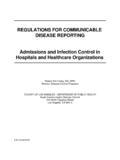Transcription of Fowl cholera - Home: OIE
1 Rev. sci. tech. Off. int. Epiz., 2000,19 (2), 626-637. Fowl cholera Christensen & M. Bisgaard Department of Veterinary Microbiology, The Royal Veterinary and Agricultural University, Stigbojlen 4, 1870 Frederiksberg C, Denmark Summary Pasteurella multocida subspecies multocida is the most c o m m o n cause of f o w l cholera , although P. multocida subspecies septica and gallicida may also cause f o w l cholera -like disease to some extent. However, the virulence properties of the different subspecies for various hosts have not been elucidated. The seventy and incidence of P. multocida infections may vary considerably depending on several factors associated w i t h the host (including species and age of infected birds), the environment and the bacterial strain.
2 No single virulence factor has been associated w i t h the observed variation in virulence among strains. Possible virulence factors include the f o l l o w i n g : the capsule, endotoxin, outer membrane proteins, iron binding systems, heat shock proteins, neuraminidase production and antibody cleaving enzymes. No RTX toxins (repeats in toxin) appear to be produced by P. multocida, but P. multocida exotoxin (PMT) could contribute to virulence in some avian infections. The epidemiology of f o w l cholera appears complex. Traditional serotyping systems are only of limited use in epidemiological studies. In recent years, molecular typing methods have been applied to avian strains of P.
3 Multocida of different origin. The results obtained using these n e w e r methods indicate that w i l d birds may be a source of infection to commercial poultry. Documentation suggesting t h a t mammals play a similar role is not as c o m p r e h e n s i v e , but the possibility cannot be excluded. Carrier birds seem to play a major role in the transmission of cholera . Surviving birds from diseased flocks appear to represent a risk, but more recent investigations indicate t h a t carriers of P. multocida may exist within poultry flocks w i t h no history of previous outbreaks of f o w l cholera . The significance of this awaits further investigation.
4 The site of infection for P. multocida is generally believed to be the respiratory tract. The outcome of infections may range f r o m peracute/acute infections to chronic infections. In the former type of infections, f e w clinical signs are observed before death and the lesions will be dominated by general septicaemic lesions. In chronic forms of P. multocida infections, suppurative lesions may be w i d e l y distributed, often involving the respiratory tract, the conjunctiva and adjacent tissues of the head. Diagnosis is always dependent upon isolation of the organism. For the detection of subclinical infections, mouse passage of relevant samples is r e c o m m e n d e d , but polymerase chain reaction and isolation attempts on selective media may represent alternatives.
5 Confinement is probably the most effective w a y to prevent introduction of P. multocida. However, extensive management systems dominate in many parts of the w o r l d , and under such circumstances vaccination is r e c o m m e n d e d as a preventive measure. Unfortunately, the development of safe and efficient live vaccines still poses problems. As a result, control remains dependent on bacterins w h i c h exhibit significant disadvantages compared to live vaccines. Keywords Avian diseases - Epidemiology - Fowl cholera - Identification - Pasteurella multocida - Pathology-Prevention. Rev. sci. tech. Off. int. Epiz., 19 (2) 627. Introduction subspecies multocida and serovar A appear to be the most frequently isolated subspecies and serogroup from cases of the For decades, the term 'avian pasteurellosis' has been used to most severe form of fowl cholera (78, 8 0 ).
6 Several of the refer to a group of diseases caused by pasteurellae and sixteen somatic serovars have been demonstrated among pasteurellae-like organisms. Important poultry pathogens serovar A isolates, just as somatic serotype variation has been such as Yersinia pseudotuberculosis (86), Riemerella shown to occur within serovars B, D and F (78). Isolates that anatipestifer (84) and Ornithobacterium rhinotracheale (94) have multiple somatic antigens are often encountered and are have all been excluded from the family Pasteurellaceae sensu considered distinct serotypes ( 9 7 ) . Although the somatic stricto (15) and will consequently not be described.
7 The genus serovars 1,3 and 3,4 within serovar A apparently dominate Pasteurella sensu stricto presently includes at least eleven among strains isolated from fowl cholera in England and the species, but only seven species (P. multocida with its three United States of America ( 2 1 , 7 9 ) , no particular serovar subspecies, P. gallinarum, P. avium, P. volantium, P. anatis, appears to be more or less virulent than others. Lee et al. P. langaa and P. sp. A) have been associated with avian hosts demonstrated that different isolates of the common serovar (6). Among these, P. multocida is considered the causative A:3,4 vary greatly in virulence ( 5 5 ).
8 Virulence properties of agent of fowl cholera ( 8 1 ) . Apart from P. multocida, none of the different subspecies for different avian hosts are unclear. the above species appear to be involved as aetiological agents in acute cholera -like disease or to be of any major economic No single factor has been associated with the strain variation importance in birds (6), and will therefore not be covered by in virulence observed (56). The capsule is regarded as a major this review. virulence factor of avian P. multocida (37, 3 8 , 8 7 , 9 3 ) , but other factors probably influence the outcome of infections. The taxonomy of organisms previously reported as Other virulence factors suggested include the following: P.
9 Haemolytica remained unsolved for many years. Recent - endotoxin (20, 25,.26, 57, 7 6 ). investigations have reclassified mammalian isolates as - outer membrane proteins (92). Mannheimia, a new genus containing at least five species (2), - iron binding systems (34, 4 9 , 6 9 , 1 0 0 ). while avian isolates belong to another new genus within the - heat shock proteins (59). family Pasteurellaceae which has not yet been named ( 1 4 ) . - neuraminidase production ( 5 1 , 5 8 ). These investigations have confirmed that host specificity seems to exist for many species of the family Pasteurellaceae. - antibody cleaving enzymes (72). Similar taxonomic investigations are in progress for the P.
10 Multocida complex, but results are not yet available. Toxins other than endotoxin may also play a role in the Consequently, the following text will be based on published pathogenesis of fowl cholera . Pasteurella multocida toxin, data only. which is at least partly responsible for the lesions observed in atrophic rhinitis in pigs (27), cannot be excluded as a possible virulence factor in some of the lesions observed in avian Description of the aetiological infections with P. multocida (15). Production of RTX toxins (repeats in toxin), which is of major importance in the agent pathogenesis of some members of the family Pasteurellaceae (24), has not been observed in P.













